Sweat 101
Sweat is the body’s way of regulating temperature. But why do you sweat and what influences this response? Get all your sweat questions answered.

The average person sweats 278 gallons per year

Nearly 5 percent of the population suffers from hyperhidrosis (excessive sweating).

Men sweat about 40% more than women (on average).

35 percent of people experience at least one weekly sweat event.
What Is Sweat?
You sweat every day. But do you know what’s really happening when those sweat droplets begin to form?
Sweat is a type of fluid secreted by your sweat glands. Perspiration is how your body thermoregulates and maintains a toasty 98.6-degree temperature. In hot weather or during activity, your body produces sweat to cool itself down.
So where does the signal to sweat begin?
The hypothalamus contains thermosensitive neurons that control sweat. When your internal temperature changes, your brain triggers a sweat response. As you sweat and high-energy molecules evaporate on your skin, your body releases energy to return to its core temperature.
Humans sweat most from these parts of the body:
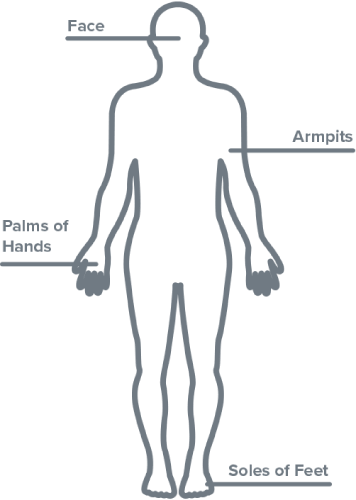
Your body also contains two types of sweat glands responsible for different sweat responses:
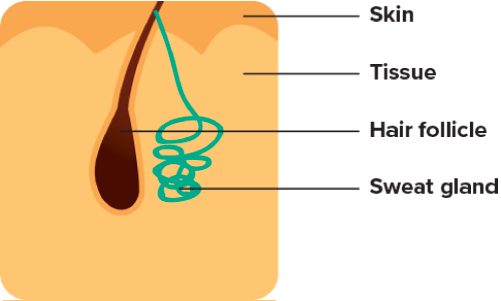
ECCRINE GLANDS
Location:
Across the skin (mainly your palms, feet, armpits and forehead).
How they work:
When your body’s internal temperature begins to rise, the hypothalamus activates these sweat glands.
As the sweat evaporates, it helps cool the skin and keep your core temperature from overheating.
Smells:
The sweat produced from these glands consists of salt and water, so it doesn’t smell.
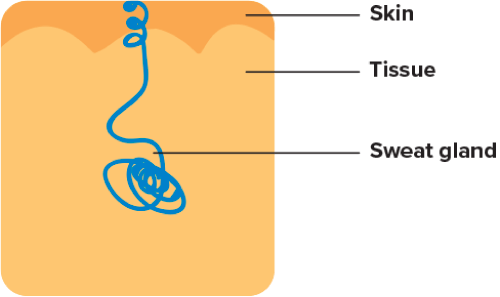
APOCRINE GLANDS
Location:
Concentrated in the armpits, groin, ear canal and eyelids.
How they work:
Typically end in hair follicles – rather than pores – and don’t develop until puberty.
Unlike eccrine glands, apocrine glands secrete a milky fluid that’s odorless until it mixes with bacteria on the skin.
Smells:
These sweat glands are often activated in times of stress, which explains why stress sweat tends to smell more than regular sweat.
Why You Sweat?
Humans are the most sophisticated and sweatiest animals on the planet. Adults can sweat up to 4 liters per hour.

Why you sweat traces back to a few evolutionary functions:
Aid in Brain Development
Sweat played a pivotal role in the brain development of early humans. As they ran long distances in the equatorial sun, their bodies developed more sweat glands to help cool their overheated brains, allowing these organs to expand and evolve into the human brain today.
Reduce Stress
Sweat cools the body during times of stress. When exposed to stressful stimuli, your fight-or-flight response center fires, and sweat is a necessary and purposeful reaction. As hormone secretion, blood flow and heart rate increase, your body sweats to help cool itself down.
Ward Off Threats
The smell of stress sweat also acts as a peer-to-peer danger alert system (unlike regular exercise sweat). In the face of predators thousands of years ago, humans needed a nonverbal way to communicate the presence of danger.
Why Everyone Sweats Differently
Why do some people sweat more in certain areas than others? Much has to do with your DNA (or predisposition to sweating) and how your sweat glands are distributed.
The placement of specific sweat glands also shapes how you sweat. If you sweat excessively in one particular area, you could have a higher concentration of sweat glands there.
For example, one area of your body might perspire first because those glands respond to your brain's signals quickest, according to dermatologist Dee Anna Glaser.
The placement of specific sweat glands also shapes how you sweat. If you sweat excessively in one particular area, you could have a higher concentration of sweat glands there.
These factors influence how much you sweat:
- Gender: Even though women have more sweat glands than men, men produce more sweat.
- Age: Teens and adults sweat more than children. Sweat usually becomes more regular during puberty, but some children start to experience sweat episodes around age 8 to 10.
- Body Mass: People with higher body mass sweat more than individuals with a normal BMI. Fat insulates the body and raises its core temperature, which means your body needs to sweat more to cool itself down.
- Physical Fitness: The fitter you are, the more you sweat. Top athletes sweat much sooner into a workout than sedentary people.
- Alcohol Intake: Drinking alcohol dilates your blood vessels, which can trigger sweat.
- Caffeine Intake: Caffeine stimulates the central nervous system and activates your sweat glands. Drinking a hot cup of coffee can also make you sweat more.
Other Causes of Sweat
Physical heat and emotional stress are two common situations that prompt your nerves to stimulate your sweat glands. Emotionally induced sweating occurs in the palms, soles of feet, armpits and forehead. Physical heat-induced sweat occurs throughout the body.
Certain situations cause you to sweat more than normal. Some of these causes of sweat include:
 Stress
Stress Hot or Humid Temperature
Hot or Humid Temperature Medications
Medications Infection or Illness
Infection or Illness Eating Spicy Foods
Eating Spicy Foods Nerves
NervesCommon Types of Sweat Issues
Sweating in normal amounts is an essential bodily function. Sweat helps cool you down when standing in the boiling heat, pushing yourself in a workout or just going about your day. But not sweating enough or sweating profusely can cause problems.
Here are the most common sweat problems:
- Stress Sweat: Stress sweat is a type of situational sweating that occurs during stressful situations, such as working to meet a deadline or juggling the demands of a career and family. Typical side effects of stress sweat include obvious sweat marks and bad odor.
- Nervous Sweat: Another type of situational sweating, nervous sweat occurs due to feelings of anxiety or worry. You might experience nervous sweat during a first date or big presentation.
- Night Sweats: Some people experience night sweats during menopause, illness or fever to help cool the body down. This type of sweat is usually temporary but can interfere with sleep.
- Hot Flashes: These shorter bouts of sweat are also the result of hormonal changes that occur during menopause. Hot flashes typically last 2 to 30 minutes and affect women for 10 years on average.
- Teen Sweating: During puberty, roughly three million apocrine sweat glands in your armpits, groin, palms and feet become more active. This can cause a sudden (and embarrassing) onset of body odor and sweat stains.
- Primary Hyperhidrosis: When you sweat heavily regardless of your environment, it's known as primary or secondary hyperhidrosis. Primary hyperhidrosis is a form of excessive sweating that has no known cause. People with primary hyperhidrosis produce more sweat than is necessary to regulate body temperature in one particular area, such as the feet, hands, head/face or armpits.
- Secondary Hyperhidrosis: People with generalized secondary hyperhidrosis sweat heavily across the body. The cause of secondary hyperhidrosis is usually a medical condition or medication.
- Hypohidrosis: The absence of sweat, known as hypohidrosis or anhidrosis, occurs when your sweat glands no longer function properly. Not being able to sweat means your body can’t cool itself down – putting you at risk of overheating.
Sweat is completely natural – but sweat marks and yellow stains can be stressful and embarrassing.
Sweat Proof Thompson Tees – The Most Effective Sweat Solution
Sweat is completely natural – but sweat marks and yellow stains can be stressful and embarrassing.
To address this issue, Thompson Tee co-founders Billy and Randy spent more than 10 years developing the only patented sweat proof technology called Hydro-Shield, which is embedded in the underarms of every premium Thompson Tee to fight sweat all day long.
This lightweight layering system traps heat and absorbs moisture rather than letting it seep through to your outer layer – providing relief from wet marks and yellowing that quickly destroy your clothing and your confidence.
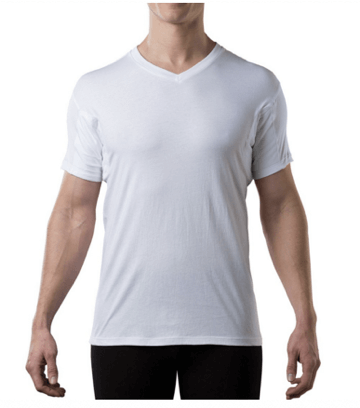

 Stress Sweat
Stress Sweat  Sweat Stains
Sweat Stains 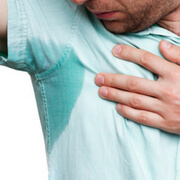 Axillary Hyperhidrosis
Axillary Hyperhidrosis  Nervous Sweating
Nervous Sweating